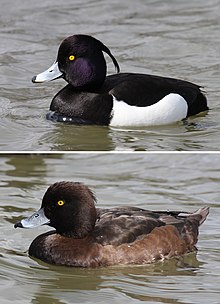Tufted duck
| Tufted duck | |
|---|---|

| |
| Male / Female | |
| Scientific classification | |
| Domain: | Eukaryota |
| Kingdom: | Animalia |
| Phylum: | Chordata |
| Class: | Aves |
| Order: | Anseriformes |
| Family: | Anatidae |
| Genus: | Aythya |
| Species: | A. fuligula
|
| Binomial name | |
| Aythya fuligula | |

| |
| Global range Year-Round Range Summer Range Winter Range
| |
| Synonyms | |
|
Anas fuligula Linnaeus, 1758 | |
The tufted duck (Aythya fuligula) is a small diving duck with a population of close to one million birds. The scientific name is derived from Ancient Greek aithuia an unidentified seabird mentioned by authors including Hesychius and Aristotle, and Latin, fuligo "soot" and gula "throat".[2]
Description
The adult male is all black except for white flanks and a blue-grey bill with gold-yellow eyes, along with a thin crest on the back of its head. It has an obvious head tuft that gives the species its name. The adult female is brown with paler flanks, and is more easily confused with other diving ducks. In particular, some have white around the bill base which resembles the scaup species, although the white is never as extensive as in those ducks. The females' call is a harsh, growling "karr", mostly given in flight. The males are mostly silent but they make whistles during courtship based on a simple "wit-oo".
The only duck which is at all similar is the drake greater scaup which, however, has no tuft and a different call.
The tufted duck is one of the species to which the Agreement on the Conservation of African-Eurasian Migratory Waterbirds (AEWA) applies.
Distribution
The tufted duck breeds throughout temperate and northern Eurasia. It occasionally can be found as a winter visitor along both coasts of the United States and Canada. It is believed to have expanded its traditional range with the increased availability of open water due to gravel extraction, and the spread of freshwater mussels, a favourite food. These ducks are migratory in most of their range, and overwinter in the milder south and west of Europe, southern Asia and all year in most of the United Kingdom. They form large flocks on open water in winter.
Habitat
Their breeding habitat is close to marshes and lakes with plenty of vegetation to conceal the nest. They are also found on coastal lagoons, the seashore, and sheltered ponds.
Food
These birds feed mainly by diving, but they will sometimes upend from the surface.[3] They eat molluscs, aquatic insects and some plants and sometimes feed at night.
Gallery
-
Ducklings
-
Male juveniles, Farmoor Reservoir, Oxfordshire
-
Male, Farmoor Reservoir, Oxfordshire
-
Female, WWT London Wetland Centre
-
Eggs, Collection Museum Wiesbaden
-
flock of 2000 tufted ducks in Ystad port, 16 January 2016
References
- ^ Template:IUCN
- ^ Jobling, James A (2010). The Helm Dictionary of Scientific Bird Names. London: Christopher Helm. pp. 64, 165. ISBN 978-1-4081-2501-4.
- ^ Ogilvie, Malcolm A. (1986). "Tufted Duck". In Lack, Peter (ed.). The Atlas of Wintering Birds in Britain and Ireland. London, UK: T & AD Poyser. p. 110. ISBN 978-1-4081-3828-1. Retrieved 12 August 2014.
External links
- Tufted Ducks video from Gallery of Living Nature.
- BirdLife species factsheet for Aythya fuligula
- "Aythya fuligula". Avibase.
- "Tufted duck media". Internet Bird Collection.
- Tufted duck photo gallery at VIREO (Drexel University)
- Interactive range map of Aythya fuligula at IUCN Red List maps
- Audio recordings of Tufted duck on Xeno-canto.







